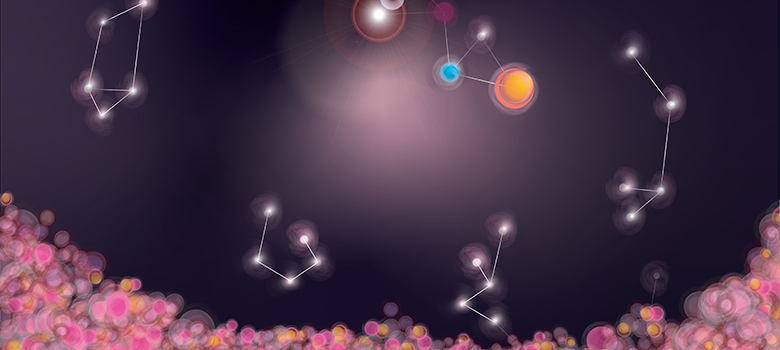
(April 17, 2019) -- Only about one in four people diagnosed with acute myelogenous leukemia (AML) survive five years after the initial diagnosis. To improve that survival rate, researchers at UTSA and the University of Texas MD Anderson Cancer Center created an online atlas to identify and classify protein signatures present at AML diagnosis.
The new protein classifications will help researchers and clinicians recommend better treatment and personalized medicine for patients suffering from this aggressive cancer, which occurs in the blood and bone marrow. The breakthrough research is published in the latest April issue of Nature Biomedical Engineering.

Amina Qutub is an Associate Professor in the UTSA Department of Biomedical Engineering.
Researcher Amina Qutub, an associate professor in the UTSA Department of Biomedical Engineering (who joined UTSA in 2018 from Rice University), and oncologist Steven M. Kornblau, a professor and practicing clinician in the Department of Leukemia at UT MD Anderson Cancer Center, examined the genetic, epigenetic and environmental diversity that occurs in cancerous cells due to AML. Analyzing proteomic screens of 205 patient biopsies obtained at MD Anderson Cancer Center, first author Chenyue Wendy Hu (then a graduate student at the Qutub Lab, now at Uber Technologies), Kornblau and Qutub developed a new computational method called MetaGalaxy to categorize the protein signatures into 154 different patterns based on their cellular functions and pathways.
By approaching this challenge through the unique lens of developing a quantitative map for each leukemia patient from protein expression in their blood and bone marrow, rather than the standard lens of qualitative metrics and genetic risks alone, Qutub, Kornblau and their research collaborators will be able to more precisely categorize patients into risk groups and better predict their treatment outcomes.
To better understand the AML hallmarks at the proteomic (protein system) level and to share the results of their work with other researchers, the UTSA biomedical engineering professor and her team including Hu, and students Andrew Ligeralde (now at the University of California, Berkeley) and Allie Raybon (from the UTSA Department of Biomedical Engineering) built a web portal known as the Leukemia Proteome Atlas. Designed by Qutub’s and Kornblau’s teams with input from clinical collaborators worldwide, the online portal gives oncologists and cancer scientists the tools they need to investigate AML protein expression patterns from one patient to the next. It also provides investigators around the world with leads for new leukemia research and new computational tools.
Since many genetic mutations cannot be targeted, the proteomic profiling and target identification process used in this research study will accelerate the identification of therapeutic targets. It also propels researchers much closer to the development of personalized combination therapies for patients based on their unique protein signatures.
“Acute myelogenous leukemia presents as a cancer so heterogeneous that it is often described as not one, but a collection of diseases,” said Qutub. “To decipher the clues found in proteins from blood and bone marrow of leukemia patients, we developed a new computer analysis - MetaGalaxy – that identifies molecular hallmarks of leukemia. These hallmarks are analogous to the way constellations guide navigation of the stars: they provide a map to protein changes for leukemia. Our ‘hallmark’ predictions are being experimentally tested through drug screens and can be ‘programmed’ into cells through synthetic manipulation of proteins. A next step to bring this work to the clinic and impact patient care is testing whether these signatures lead to the aggressive growth or resistance to chemotherapy observed in leukemia patients. At the same time, to rapidly accelerate research in leukemia and advance the hunt for treatments, we provide the hallmarks in an online compendium where fellow researchers and oncologists worldwide can build from the resource, tools and findings, LeukemiaAtlas.org.”
Learn more about the Leukemia Proteome Atlas and read the paper in Nature Biomedical Engineering.
Celebrate UTSA’s 50th Anniversary and share social media posts about the 50th using the hashtag #UTSA50.
Connect with UTSA online at Facebook, Twitter, YouTube, Instagram and LinkedIn.
UTSA Today is produced by University Communications and Marketing, the official news source of The University of Texas at San Antonio. Send your feedback to news@utsa.edu. Keep up-to-date on UTSA news by visiting UTSA Today. Connect with UTSA online at Facebook, Twitter, Youtube and Instagram.
Move In To COLFA is strongly recommended for new students in COLFA. It gives you the chance to learn about the Student Success Center, campus resources and meet new friends!
Academic Classroom: Lecture Hall (MH 2.01.10,) McKinney Humanities BldgWe invite you to join us for Birds Up! Downtown, an exciting welcome back event designed to connect students with the different departments at the Downtown Campus. Students will have the opportunity to learn about some of the departments on campus, gain access to different resources, and collect some giveaways!
Bill Miller PlazaJoin us for an intimate evening of cocktails, conversation, and culinary inspiration with Pati Jinich, Emmy-nominated chef and James Beard Award-winning author. Enjoy light bites and signature drinks in the warm, modern setting of Mezquite as Pati connects with guests over her passion for Mexican cuisine and storytelling.
Mezquite Restaurant in Pullman Market, 221 Newell Ave., San Antonio 78215From inspired courses to thoughtful pairings and a rich sense of community, the Ven a Comer Signature Dinner is a night of shared meals, shared stories, and unforgettable flavor.
Stable Hall (Pear Brewery), 307 Pearl Pkwy, San Antonio 78215Come and celebrate this year's homecoming at the Downtown Campus with food, games, giveaways, music, and more. We look forward to seeing your Roadrunner Spirit!
Bill Miller PlazaThe University of Texas at San Antonio is dedicated to the advancement of knowledge through research and discovery, teaching and learning, community engagement and public service. As an institution of access and excellence, UTSA embraces multicultural traditions and serves as a center for intellectual and creative resources as well as a catalyst for socioeconomic development and the commercialization of intellectual property - for Texas, the nation and the world.
To be a premier public research university, providing access to educational excellence and preparing citizen leaders for the global environment.
We encourage an environment of dialogue and discovery, where integrity, excellence, respect, collaboration and innovation are fostered.